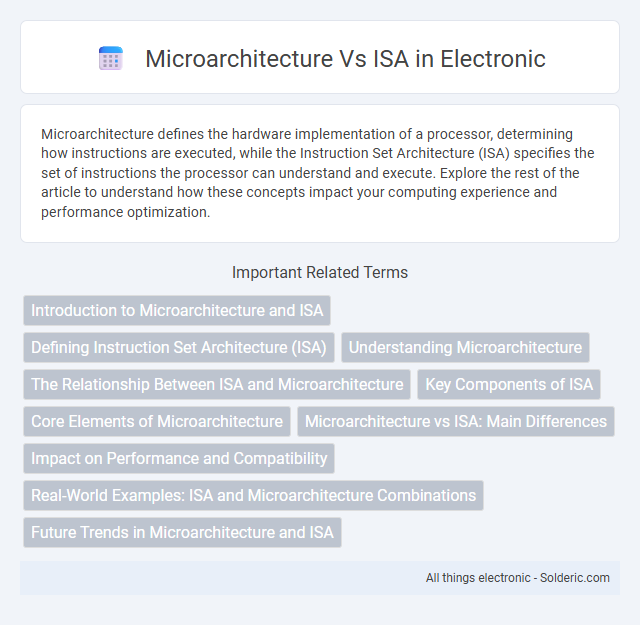Microarchitecture defines the hardware implementation of a processor, determining how instructions are executed, while the Instruction Set Architecture (ISA) specifies the set of instructions the processor can understand and execute. Explore the rest of the article to understand how these concepts impact your computing experience and performance optimization.
Comparison Table
| Aspect | Microarchitecture | ISA (Instruction Set Architecture) |
|---|---|---|
| Definition | Implementation of a processor's design at the hardware level. | Set of instructions and programming model exposed to software. |
| Focus | Hardware structure: datapaths, control units, pipelines. | Instruction formats, operations, registers, addressing modes. |
| Role | Determines performance, efficiency, hardware complexity. | Defines software compatibility and programming interface. |
| Visibility | Invisible to programmers, internal CPU design. | Visible to programmers and compilers. |
| Flexibility | Can vary widely for the same ISA. | Fixed for a given processor family or architecture. |
| Examples | Out-of-order execution, superscalar pipelines (e.g., Intel Core, AMD Zen). | x86, ARM, RISC-V instruction sets. |
Introduction to Microarchitecture and ISA
Microarchitecture defines the hardware implementation details of a processor, including components like ALUs, registers, and cache, while Instruction Set Architecture (ISA) specifies the set of instructions a processor can execute and the programmer-visible behavior. The ISA serves as the interface between software and hardware, enabling software portability across different microarchitectures implementing the same ISA. Microarchitecture optimizes performance, power, and area within the constraints set by the ISA, ensuring efficient execution of instruction sets.
Defining Instruction Set Architecture (ISA)
Instruction Set Architecture (ISA) defines the set of instructions that a processor can execute, serving as the critical interface between software and hardware. It specifies the operations, data types, registers, addressing modes, and memory architecture that developers use to write machine-level programs. Your understanding of ISA is essential for optimizing software performance and ensuring compatibility across different microarchitectures implementing the same ISA.
Understanding Microarchitecture
Microarchitecture refers to the detailed organization and operational structure of a CPU, including components like the ALU, registers, cache, and control unit, which directly affect processing speed and efficiency. Unlike the Instruction Set Architecture (ISA) that defines the set of instructions a processor can execute, microarchitecture determines how those instructions are implemented and optimized at the hardware level. Understanding microarchitecture helps you grasp how different designs impact performance, power consumption, and overall system behavior.
The Relationship Between ISA and Microarchitecture
The Instruction Set Architecture (ISA) defines the set of machine instructions that a processor can execute, serving as the critical interface between software and hardware. Microarchitecture implements the ISA by specifying the internal organization and data paths of a processor, including components such as pipelines, caches, and execution units. Changes in microarchitecture can optimize performance and efficiency without altering the ISA, ensuring software compatibility across different processor designs.
Key Components of ISA
Instruction Set Architecture (ISA) comprises key components such as the instruction set, which defines the commands a processor can execute, addressing modes that specify how to access data, and the processor registers used for temporary data storage. It also includes the data types supported, memory architecture outlining how memory is organized and accessed, and the input/output mechanisms enabling communication with peripheral devices. These components collectively define the interface between software and hardware, guiding microarchitecture design and implementation.
Core Elements of Microarchitecture
Microarchitecture defines the core elements such as the datapath, control unit, and memory hierarchy that dictate how instructions are executed within a processor. The datapath includes components like registers, ALUs, and buses essential for handling data operations, while the control unit interprets ISA instructions to generate control signals for these components. Efficient design of these microarchitectural elements directly influences your CPU's performance and energy efficiency.
Microarchitecture vs ISA: Main Differences
Microarchitecture defines the physical implementation of a processor's design, including components like pipelines, caches, and execution units, directly influencing performance and efficiency. ISA (Instruction Set Architecture) specifies the set of instructions a processor can execute, serving as the interface between software and hardware. Understanding the main differences helps you optimize software for compatibility with specific hardware capabilities and boost overall system performance.
Impact on Performance and Compatibility
Microarchitecture defines the hardware implementation of an Instruction Set Architecture (ISA), directly impacting processor performance through factors like pipeline depth, cache size, and execution units. The ISA sets the compatibility standard, ensuring software runs across different microarchitectures that adhere to the same instruction set. Understanding the distinction helps you optimize system design for both high performance and broad compatibility.
Real-World Examples: ISA and Microarchitecture Combinations
Intel's x86 ISA is commonly paired with diverse microarchitectures such as Skylake and Ice Lake, optimizing performance across desktops, laptops, and servers. ARM's ISA supports microarchitectures like Cortex-A72 and Cortex-A77, widely used in smartphones and embedded systems for energy efficiency and processing power. Your choice of ISA and microarchitecture combination directly impacts device compatibility, power consumption, and computational capabilities in real-world applications.
Future Trends in Microarchitecture and ISA
Future trends in microarchitecture emphasize increased parallelism, energy efficiency, and integration of AI-specific accelerators to enhance computational performance. Instructions Set Architectures (ISA) are evolving with flexible and extensible designs that support domain-specific workloads and heterogeneous computing environments. Your computing experience will benefit from this synergy, resulting in faster, more efficient processors tailored to emerging applications.
Microarchitecture vs ISA Infographic

 solderic.com
solderic.com